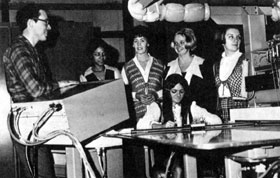NAL Film Analysis Facility Looks for Sub-atomic "Clues"

Several members of NAL's film scanning group: (L to R) Ray Hanft, Carol Long, Judy Dill, Dawn Chartrand, and Christine Dedin. Seated is Annette Albano Photo by Tony Frelo, NAL
(This is the first of two articles concerning NAL's recently-organized Film Analysis Facility. It was written with the assistance of Ray Hanft, Physics Research; Ernest Malamud, Main Ring; Richard Mobley, Beam Targetry; and Roland Juhala, Booster.)
Some of the most significant and enigmatic mysteries of our time are being viewed almost daily on motion picture film by men and women at NAL who are looking for "clues" that may help unravel nuclear "events." In a white pole building at the northeastern edge of NAL's Village, at 34 Shabbona, is centered the Laboratory's Film Analysis Facility (FAF). There are few like it in the world.
Five young women sit quietly at unique tables for long periods, from 8:30 a.m. to 5 p.m. daily, and another joins them at 4 p.m. to work until midnight. All are engaged in "scanning" -- an esoteric, but vital occupation peculiar to elementary particle physics. They are "scanning" films in a search for sub-atomic "incidents" recorded on special photographic equipment at bubble chambers at various physics research laboratories across the nation. Soon, they will be "scanning" such film resulting from complex experiments to be conducted with the assistance of NAL's accelerator system.
The Film Analysis Facility group works in an atmosphere of sleek austerity, a sleekness that is incongruous when one learns about the complexity of the work being undertaken there. The facilities are new, with construction still going on. Physicists directing the effort sit in small, cubicle-like offices with their desks piled high with computer printouts which they handle like a housewife hoarding recipe cards. They shuffle through their 10-foot-long cards until they find the right combination for the "dish" they currently are cooking up for their intellectual diets.
Many methods are used for recording scientific data from high energy physics experiments. Optical spark chambers and bubble chambers use photographic film to record the capricious trajectories of charged particles. In optical spark chambers, the charged particles produce sparks along their trajectories. In bubble chambers, they produce bubbles along their trajectories. From scanning the photographs of a given particle trajectory from two or more different directions, it is possible to determine the angles and curvature in space of the trajectory.
Parenthetically, it might be noted that a liquid detector that grew out of watching bubbles form in a glass of beer led to a Nobel Prize in physics in 1960. Donald A. Glaser, an American physicist, pointed out in 1952 that bubbles will form along the track of a charged particle that has passed through a superheated liquid. The high density of the liquid makes it far superior to the old-fashioned cloud chambers that exhibited jet-like vapor trails for lazy, slow particles but were inefficient for tracking the kangaroo-like trail of super-energetic radiation.
At NAL's FAF, bubble chamber film is checked by the "scanners" who carefully review each set of photographs to see if the "events" they discover are "interesting" as defined by physicists who conducted the experiments. (Note: A new elementary particle of matter, the omega meson, predicted for several years on theoretical grounds, was found only after 30,000 photographs had been analyzed at the Lawrence Radiation Laboratory in 1961.) When interesting events are found, information about the trajectories is recorded in digital form suitable for computer analysis.
"Scanners" use manually-operated film editing equipment specially designed for their work. NAL already has purchased some such equipment; other items have been loaned by Lawrence Radiation Laboratory at Berkeley, Calif., Brookhaven National Laboratory, New York, and Yale University, Connecticut. The degree of success depends, of course, on the skill, judgment, long-range experience and briefings provided the "scanners."
One principal project at FAF now is the development of an "Automatic Measuring Facility" for NAL. The automatic facility will be capable of increasing the rate of scanning and measuring with the aid of semi-automatic control supplied by the DEC PDP-10 computer located in the FAF building.
The general complexity of some events, however, precludes the possibility of a fully automatic operation. Hence, in cases where the complexity of the event is beyond the analysis capabilities of the recognition programs in the PDP-10, an operator will be asked to provide objective aid. The net result should be to increase the measuring capability of a single operator by a factor of ten or more.
Design of NAL's "Automatic Measuring Facility" began about a year ago, and construction is now underway. First measurement using the automatic device is projected for late 1971 or early 1972, corresponding with the anticipated appearance of the first bubble chamber data from NAL. Physicists associated with this project include Virgil D. Bogert and Raymond Hanft; engineering design work is being done by James DeShong and Robert Cavanaugh. Bruce L. Chrisman and Glenn C. Johnson are working on computer programs for the PDP-10. Technical support for all aspects of FAF is provided by Richard J. Bingham, Delwyn Burandt, Carlos Cangemi, Curtis R. Danner, and Martin Glass. All are members of the NAL Physics Research group.


